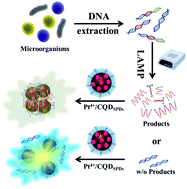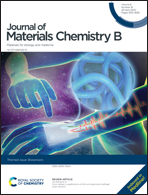Platinum ions mediate the interactions between DNA and carbon quantum dots: diagnosis of MRSA infections†
Abstract
In this study, we have developed a rapid and cost-effective method employing platinum ion (Pt4+)-capped fluorescent carbon quantum dots (CQDs) coupled with loop-mediated isothermal amplification (LAMP) to detect dual MRSA genes. We synthesized nitrogen- and chlorine-co-doped fluorescent CQDs (CQDSPDs) from spermidine trihydrochloride via a simple one-step pyrolysis. The CQDSPDs capped with Pt4+ ions through the cooperative coordination of the amine and chlorine groups on the surface of CQDs facilitated the double-stranded DNA (dsDNA)-induced fluorescence quenching of CQDs, and enabled the construction of the CQDSPDs/Pt4+ probe for the detection of as few as 10 copies of the MRSA gene (mecA and femA). The sensitivity and specificity of the CQDSPDs/Pt4+ probe for MRSA detection in clinical specimens (n = 24) were 94% and 86%, respectively. Our results reveal that the CQDSPDs/Pt4+ probe has great potential for the diagnosis of antibiotic-resistant superbugs with high sensitivity, specificity, and agreement.

- This article is part of the themed collection: Biosensors


 Please wait while we load your content...
Please wait while we load your content...